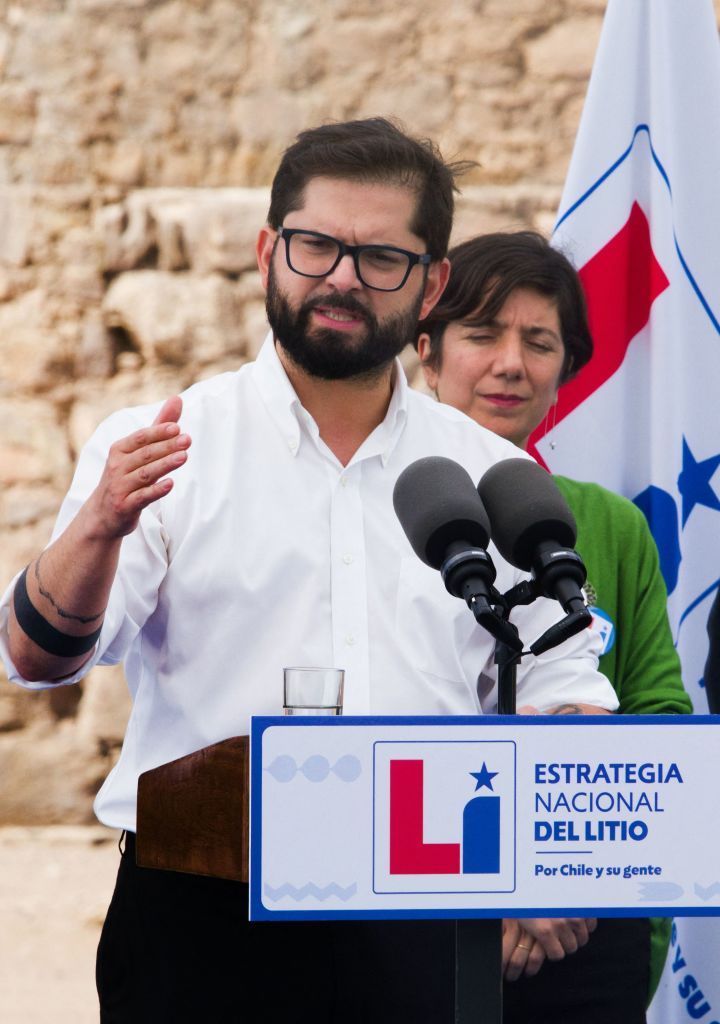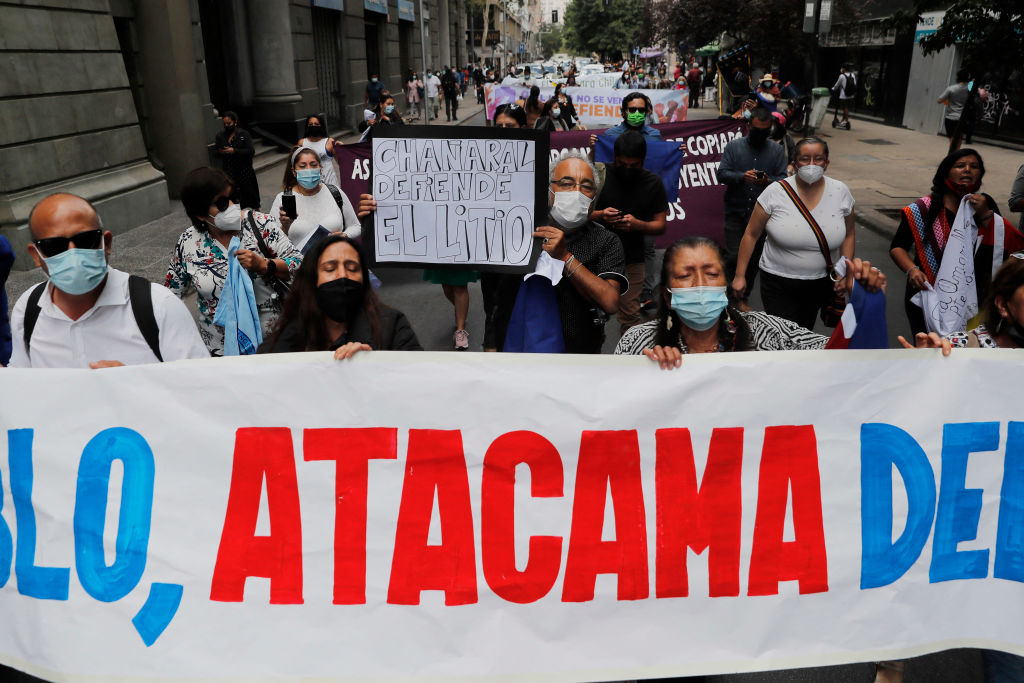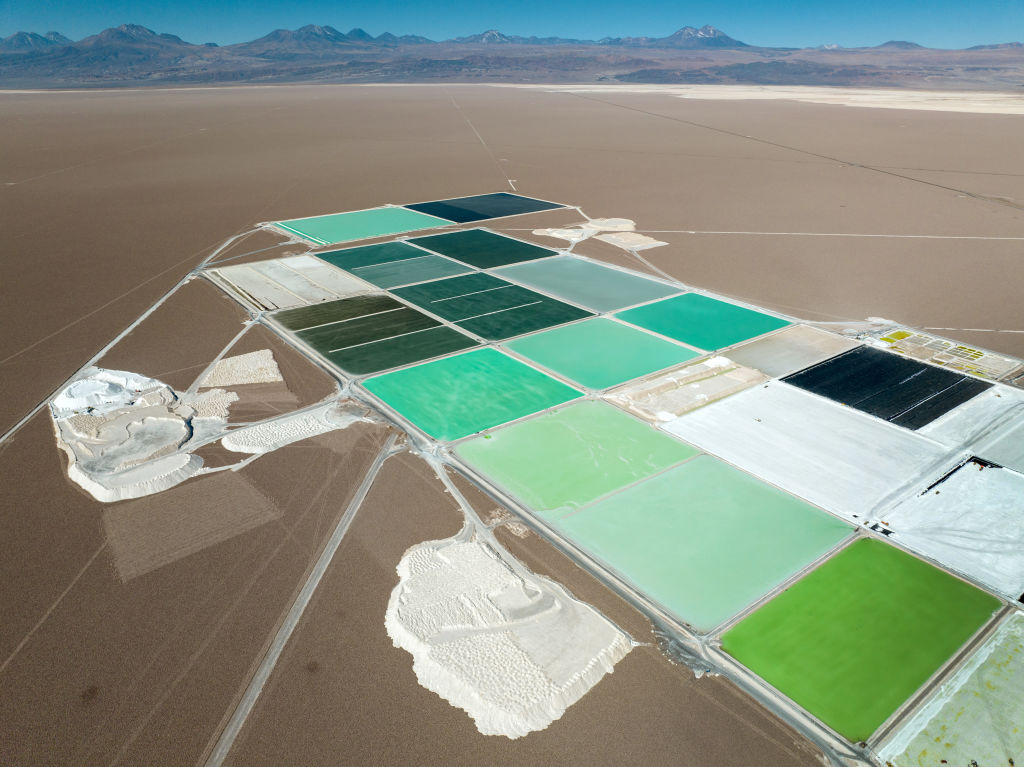Latin America is embarking on a bold and risky shake up on lithium, an essential component in electric vehicle batteries whose price has soared in recent years. Last week Chile, the world’s second-largest lithium producer, unveiled a plan to bring its industry under state control. The country’s two existing lithium mines in the Atacama desert—currently operated by U.S. mining giant Albemarle and Chile’s SQM—will pass to a state mining company within a few decades. And any future projects must now be run as public-private partnerships, and utilize emerging, more sustainable extraction technologies.
The semi-nationalization is the latest in a wave of similar moves in Latin America, a region that holds 56% of the world’s identified lithium deposits. Bolivia, which holds 21% of global resources—the largest share of any country—has always kept its lithium in state hands, and in 2021 introduced extraction-technology restrictions similar to what Chile is proposing now. Mexico (1.7% of resources) hasn’t set any technology rules yet but it did nationalize its industry in February, plunging several exploration deals into uncertainty. And even though Argentina (20% of resources), is an outlier, with a pro-businesses set of policies and dozens of private sector projects in the pipeline, officials there have joined the other three countries in recent months to discuss setting up a strategic regional alliance on lithium—or, in the words of Bolivian president Luis Arce “a kind of lithium OPEC.”
The dream of creating state-controlled, globally powerful lithium industries in the same vein as the Organization of Petroleum Exporting Countries reflects the transformed status of the mineral. A couple of decades ago, it was a niche product, mostly used to make ceramics and glass. But the energy transition, which needs lithium for EVs and a host of other other rechargeable battery products, is fuelling unprecedented demand. That means intensifying political pressure for the region’s governments to carve out a bigger piece of the lithium pie for the people.
These are risky moves: industry analysts warn that the region’s politicians may be overestimating the weight that their mostly nascent lithium sectors hold in the global market, thereby driving investment away. Still, big hopes are being pinned on the silvery white mineral. Gabriel Boric, Chile’s leftist president, told his country that state control of lithium is the “best chance we have at transitioning to a sustainable and developed economy.”

Talk of an OPEC for lithium suggests these leaders may hope to bring lithium down the same path that oil took in the 1950s to 1980s. It was in that period that, angered by multinational companies cutting prices for their product, oil-producing countries like Venezuela and Saudi Arabia gradually increased state involvement in their industries and launched OPEC. The cartel today controls 40% of the global oil supply and colludes to manipulate prices by cutting or increasing production. A similar trajectory for lithium could, in theory, help Latin America boost prices. Countries could also try to pressure businesses to move more profitable parts of the lithium supply chain—such as processing and battery component manufacturing—to a region that today only exports the raw material.
Read more: New Lithium Mining Technology Could Give Argentina a Sustainable Gold Rush
The lithium industry is, to put it mildly, skeptical. For starters, lithium is not oil. While demand is expected to explode from 23,500 tons in 2010 to up to 4 million tons in 2030, for now lithium is still traded like a specialist chemical product, rather than a major commodity. That makes it harder to set or manipulate a standardized price.
Second, the window in which Latin America can exert significant influence on the global lithium market may be closing. While the region accounted for a third of global production in 2022, that share is expected to shrink in the coming decades.
That’s in part because higher lithium prices make it viable for countries around the world to develop lithium deposits that were previously too expensive to access. South America’s lithium is found in brines in its vast salt lakes. Lithium can be relatively cheaply extracted from brines, but the process is slow and can be complicated by the quality of the brines. (Bolivia, for example, still hasn’t found an efficient way to extract its lithium, and has yet to produce significant amounts.) Meanwhile mining of lithium deposits found in hard-rock formations in Australia and China, the world’s largest and third-largest producers respectively, is rapidly expanding. Those countries seem unlikely to dabble in a potential “OLEC.”
The threat for Chile, and other Latin American countries that have less-developed lithium sectors, is that investors, spooked by last week’s news, take the massive amounts of cash needed to set up mines elsewhere. “In a market that needs such capital deployment over the next few years, talk around nationalization of assets really has a fundamental impact on the flow of capital,” says Andrew Miller, chief operating officer of price reporting agency Benchmark Minerals.
There are some bright spots for South American lithium in governments’ increasingly “proactive” attitude and their appetite for regional cooperation, says Miller. The new methods that both Bolivia and Chile are betting on to reduce environmental impacts are also designed to make extraction more efficient—and profitable. Known as “direct lithium extraction,” the tech unproven, but state support, plus the sharing of information and expertise between nations, could accelerate its development, and potentially restore brines’ edge in the global market.

In Chile, Boric’s government argues that laying out its public-private partnership strategy will create the certainty needed to spur investment. Lithium exploration outside of the two Atacama projects has stalled over the last three decades, due to uncertainty about Chile’s mining rights regime, which governments have been reluctant to update amid increased public scrutiny on the industry.
Daniel Jimenez, a former SQM executive and founding partner of Santiago-based lithium consultancy iLiMarkets, is not convinced. He says the terms of the new deal, which would relegate private companies to minority partners in projects, are too onerous for firms to want to take on the risky, costly work of exploring for lithium and turning reserves into active mines. “Under these conditions, I don’t think any sensible company will put their own money into such an exploration,” he says.
Some environmental activists in Chile may think that is good news. Mining in the Atacama has been blamed for using up the desert’s water resources, threatening ecosystems and local communities.
But for regional governments desperate to get a fairer deal amid the energy transition than in previous fossil-fuel eras of development, while keeping investment flowing, there’s a tightrope to walk. And it’s not clear they’ve found their balance yet.
A version of this story also appears in the Climate is Everything newsletter. To sign up, click here.
More Must-Reads from TIME
- Cybersecurity Experts Are Sounding the Alarm on DOGE
- Meet the 2025 Women of the Year
- The Harsh Truth About Disability Inclusion
- Why Do More Young Adults Have Cancer?
- Colman Domingo Leads With Radical Love
- How to Get Better at Doing Things Alone
- Michelle Zauner Stares Down the Darkness
Write to Ciara Nugent at ciara.nugent@time.com
